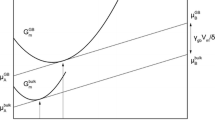Abstract
Based on the free-energy density functional method (the Cahn–Hilliard equation), a phenomenological model that describes the influence of grain boundaries on the distribution of components in binary alloys has been developed. The model is built on the assumption of the difference between the interaction parameters of solid solution components in the bulk and at the grain boundary. The difference scheme based on the spectral method is proposed to solve the Cahn-Hilliard equation with interaction parameters depending on coordinates. Depending on the ratio between the interaction parameters in the bulk and at the grain boundary, temperature, and alloy composition, the model can give rise to different types of distribution of a dissolved component, namely, either depletion or enrichment of the grain-boundary area, preferential grainboundary precipitation, competitive precipitation in the bulk and at the grain boundary, etc.
Similar content being viewed by others
References
L. Priester, Grain Boundaries: From Theory to Engineering (Springer, Dordrecht, 2013).
V. N. Chuvil’deev, Nonequilibrium Grain Boundary in Metals. Theory and Applications (Fizmatlit, Moscow, 2004) [in Russian].
R. A. Andrievski and A. M. Glezer, Phys. Usp. 52, 315 (2009).
K. Kelton and A. Greer, Nucleation in Condensed Matter (Elsevier, Amsterdam, 2010).
S. E. Restrepo, S. T. Giraldo, and B. J. Thijsse, Mod. Simul. Mater. Sci. Eng. 21, 055017 (2013).
K. C. Alexander and C. A. Schuh, Mod. Simul. Mater. Sci. Eng. 24, 065014 (2016).
S. Bhattacharyya, T. Wook, H. K. Chang, and L.-Q. Chen, Mod. Simul. Mater. Sci. Eng. 19, 035002 (2011).
M. Javanbakht and V. I. Levitas, Phys. Rev. B 94, 214104 (2016).
B. S. Bokshtein, V. A. Esin, and A. O. Rodin, Phys. Met. Metallogr. 109, 316 (2010).
G. Kaptay, J. Mater. Sci. 51, 1738 (2016).
P. Lejcek, S. Hofmann, and J. Janovec, Mater. Sci. Eng. A 462, 76 (2007).
B. V. Fedoseev and E. N. Fedoseeva, JETP Lett. 97, 408 (2013).
A. D. Brailsford and H. B. Aaron, J. Appl. Phys. 40, 1702 (1969).
V. V. Slezov, L. N. Davydov, and V. V. Rogozhkin, Phys. Solid State 37, 1964 (1995).
V. V. Slezov, L. N. Davydov, and V. V. Rogozhkin, Phys. Solid State 40, 226 (1998).
M. K. Mitra and M. Muthukumar, J. Chem. Phys. 134, 044901 (2011).
T. Frolov, M. Asta, and Y. Mishin, Phys. Rev. B 92, 020103(R) (2015).
C. Hin, Y. Brerchet, P. Maugis, and F. Soisson, Acta Mater. 56, 5653 (2008).
A. Umantsev, Field Theoretic Method in Phase Transformations (Springer, New York, 2012).
I. Steinbach, Mod. Simul. Mater. Sci. Eng. 17, 073001 (2009).
J. Cahn, Acta Metall. 9, 795 (1961).
P. E. L’vov and V. V. Svetukhin, Phys. Solid State 58, 1432 (2016).
P. E. L’vov, V. V. Svetukhin, and K. S. Maslov, Tech. Phys. Lett. 42, 856 (2016).
P. E. L’vov and V. V. Svetukhin, Phys. Solid State 59, 355 (2017).
S. Dai and Q. Du, J. Comp. Phys. 310, 85 (2016).
D. Lee, J.-Y. Huh, D. Jeong, J. Shin, A. Yun, and J. Kim, Comp. Mater. Sci. 81, 216 (2014).
D. Scheiber, R. Pippan, P. Puschnig, and L. Romaner, Mod. Simul. Mater. Sci. Eng. 24, 085009 (2016).
L. D. Landau and E. M. Lifshitz, Course of Theoretical Physics, Vol. 5: Statistical Physics (Nauka, Moscow, 1995; Pergamon, Oxford, 1980).
P. E. L’vov and V. V. Svetukhin, Phys. Solid State 57, 1213 (2015).
C. Zhang and M. Enomoto, Acta Mater. 54, 4183 (2006).
J. W. Cahn and J. E. Hilliard, J. Chem. Phys. 28, 258 (1958).
P. E. L’vov and V. V. Svetukhin, Phys. Solid State 56, 1889 (2014).
L.-Q. Chen and J. Shen, Comp. Phys. Commun. 108, 147 (1998).
J. Zhu, L.-Q. Chen, J. Shen, and V. Takare, Phys. Rev. E 60, 3564 (1999).
Author information
Authors and Affiliations
Corresponding author
Additional information
Original Russian Text © P.E. L’vov, V.V. Svetukhin, 2017, published in Fizika Tverdogo Tela, 2017, Vol. 59, No. 12, pp. 2425–2434.
Rights and permissions
About this article
Cite this article
L’vov, P.E., Svetukhin, V.V. Influence of grain boundaries on the distribution of components in binary alloys. Phys. Solid State 59, 2453–2463 (2017). https://doi.org/10.1134/S1063783417120253
Received:
Accepted:
Published:
Issue Date:
DOI: https://doi.org/10.1134/S1063783417120253



